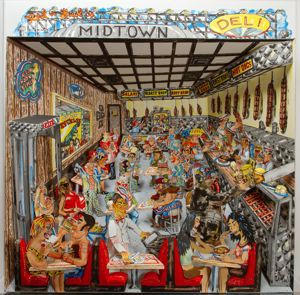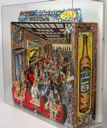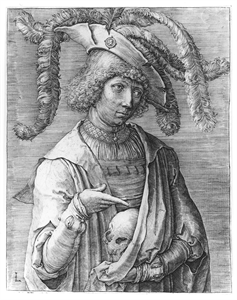
Red Grooms
American, born 1937
One of the most important influences in Grooms’ career is his relationship to the city of New York. From the outset, Grooms has been fascinated with city life, and all of the noises and the movement associated with it. First Chicago, then New York became the inspiration for many of his prints. In his early career, scenes of the city usually depicted the negative aspects. For example, in Nervous City (1971), Grooms depicts a crowded, dirty street scene characterized by drugs, violence, and sex. However, over time, he began to gain a much more positive outlook and began producing images such as Deli.
In terms of subject matter, Deli is a typical example of Grooms’ prints. Early in his career, Grooms worked in large-scale, mixed media installations, such as Ruckus Manhattan, which viewers walked through. While he has since scaled down his productions, Deli exhibits the same fascination with the city and its inhabitants as Ruckus Manhattan. Grooms’ depictions of the city are often described as nostalgic, especially when compared to earlier works such as Nervous City. The air of fear and chaos has been replaced by a more positive tone. Deli is still crowded, yet there is a sense of order and bustling prosperity; there is no element of violence. The seedier underbelly of the city has been removed almost completely. (The only hint of it lies in the bookie in the dirty coat buying a large beer. But even he is presented in a non-threatening manner, and he is not the focus of the work.) What is most apparent is the diversity of the patrons in the deli. Grooms seems to highlight the fact that New York is a truly American melting pot where people from all types of backgrounds and ethnicities can mingle in common public spaces. The distorted perspective that occurs here and in many of Grooms’ other cityscapes enhances the sense fast-paced energy generally associated with a city like New York.
Bud Shark of Shark, Ink., was the master printer for Deli. Grooms and Shark have had a productive relationship since they began making prints together in 1981. The collaboration of an artist and master printer is critical in complicated three-dimensional projects such as Deli. Grooms notes, “the chemistry between an artist and a printer will determine what types of projects they will undertake together.” (1) Grooms pays tribute to their collaboration with the advertisement on the wall for “Bud Beer,” and in the name of the establishment, “Red and Bud’s Midtown Deli.”
(1) Walter Knestrick, Red Grooms: The Graphic Work, Essay by Vincent Katz, New York: Harry N. Abrams, Inc., 2001, p. 34.
American, born 1937
Deli
2004
Object Type:
Print
Creation Place:
North America, American
Dimensions:
26 1/4 in. x 26 1/8 in. x 7 1/2 in. (66.68 cm x 66.36 cm x 19.05 cm)
Medium and Support:
Three-dimensional color lithograph on paper
Accession Number:
2006.0007
Credit Line:
Montgomery Museum of Fine Arts Association Purchase
Copyright:
© Red Grooms Estate / Artists Rights Society (ARS), New York
One of the most important influences in Grooms’ career is his relationship to the city of New York. From the outset, Grooms has been fascinated with city life, and all of the noises and the movement associated with it. First Chicago, then New York became the inspiration for many of his prints. In his early career, scenes of the city usually depicted the negative aspects. For example, in Nervous City (1971), Grooms depicts a crowded, dirty street scene characterized by drugs, violence, and sex. However, over time, he began to gain a much more positive outlook and began producing images such as Deli.
In terms of subject matter, Deli is a typical example of Grooms’ prints. Early in his career, Grooms worked in large-scale, mixed media installations, such as Ruckus Manhattan, which viewers walked through. While he has since scaled down his productions, Deli exhibits the same fascination with the city and its inhabitants as Ruckus Manhattan. Grooms’ depictions of the city are often described as nostalgic, especially when compared to earlier works such as Nervous City. The air of fear and chaos has been replaced by a more positive tone. Deli is still crowded, yet there is a sense of order and bustling prosperity; there is no element of violence. The seedier underbelly of the city has been removed almost completely. (The only hint of it lies in the bookie in the dirty coat buying a large beer. But even he is presented in a non-threatening manner, and he is not the focus of the work.) What is most apparent is the diversity of the patrons in the deli. Grooms seems to highlight the fact that New York is a truly American melting pot where people from all types of backgrounds and ethnicities can mingle in common public spaces. The distorted perspective that occurs here and in many of Grooms’ other cityscapes enhances the sense fast-paced energy generally associated with a city like New York.
Bud Shark of Shark, Ink., was the master printer for Deli. Grooms and Shark have had a productive relationship since they began making prints together in 1981. The collaboration of an artist and master printer is critical in complicated three-dimensional projects such as Deli. Grooms notes, “the chemistry between an artist and a printer will determine what types of projects they will undertake together.” (1) Grooms pays tribute to their collaboration with the advertisement on the wall for “Bud Beer,” and in the name of the establishment, “Red and Bud’s Midtown Deli.”
(1) Walter Knestrick, Red Grooms: The Graphic Work, Essay by Vincent Katz, New York: Harry N. Abrams, Inc., 2001, p. 34.
Keywords
Click a term to view the records with the same keyword
Additional Images
Click an image to view a larger version
Portfolio List
Click a portfolio name to view all the objects in that portfolio
This object is a member of the following portfolios:
Your current search criteria is: All Object records.

 by Artist (743)
by Artist (743)

